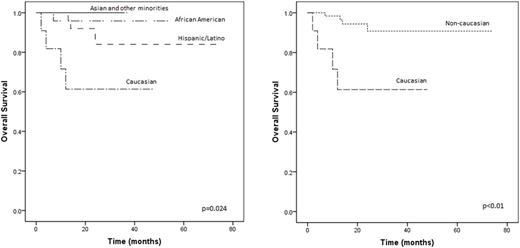Abstract
Diffuse large B-cell lymphoma (DLBCL) is the most common aggressive lymphoma worldwide representing about one-third of all lymphoma cases. However, despite advances in molecular risk-stratification modalities, there is a paucity of data addressing clinical and survival differences between racial minorities with DLBCL in the post-rituximab era.
Aim
To determine baseline characteristics and explore differences in clinical presentation and survival of patients with DLBCL in an underserved population that includes racial minorities.
Methods
We conducted a single cohort study of patients diagnosed with DLBCL from June 1st 2011 to May 1st 2017. We identified DLBCL patients using ICD coding from our tumor registry. We only included patients with biopsy-proven DLBCL in the analysis. We abstracted demographic, biochemical, inmunohistochemical and treatment variables. We used the Revised International Prognostic Index (R-IPI) to classify patients into very good, good and poor prognosis categories. Lactate dehydrogenase (LDH) levels above 1 time the upper normal limit was considered elevated. Double-hit lymphomas (DHL) were defined as DLBCL with translocations in two genes: one involving the gene MYC and another involving genes BCL-2 or BCL-6. Complete response (CR) to chemotherapy was defined as no evidence of residual disease on computed tomography and/or positron emission tomography/computed tomography. Our primary clinical outcome was overall survival (OS). We used SPPS version 19.0 for statistical analysis, specifically for chi-square, t-test and Kaplan Meier method. All patients were censored at time of death and last follow up.
Results
Out of 108 identified patients, we included only 78 patients in the analysis as 30 of them either lacked tissue diagnosis or had an incorrect ICD code. From a total of 78 eligible patients, 54 (69%) were men, predominantly Latino/Hispanic (40%) and African American (35%), had a median age of 55 years (20-95), with advanced disease (69% stage III or IV), extranodal involvement (61%) and elevated LDH (mean 368 U/liter) at presentation. The majority of patients (60%) were classified in the "good" prognostic category based on the R-IPI. Using Hans algorithm, 42 (54%) patients were classified as germinal center origin.
All patients in the cohort received chemotherapy (R-CHOP, 71%, DA-EPOCH-R, 19% or Other 10%). Sixty (77%) achieved CR and 8 (10%) had refractory/progressive disease.
When compared to other racial groups, caucasian patients showed a trend of a higher prevalence of DHL (18%, vs 12% p=0.57), high LDH levels (27% vs 19% p=0.55), and worse response to chemotherapy (Partial Response/Progressive Disease 36% vs 21%, p=0.26).
The mean OS of the entire cohort was 65 months (95% CI, 59-70 months). During a median follow up time of 17 months (0-73 months), 8 (10%) patients died, from which 4 (50%) where caucasian, 3 (38%) latinos and 1 (12%) African american. Asian and "other minorities" groups did not experience the primary outcome. When we stratified groups by race, caucasian patients had worse overall survival when compared to hispanic/latino and african american (mean, 31 months vs 64 months vs 51 months, p<0.01).
Conclusion
In our institution, caucasian patients with DLBCL had a more aggressive disease and worse OS when compared to rest of the cohort. Larger studies are needed to validate this differences in clinical presentation and overall survival between racial groups.
No relevant conflicts of interest to declare.
Author notes
Asterisk with author names denotes non-ASH members.


This feature is available to Subscribers Only
Sign In or Create an Account Close Modal